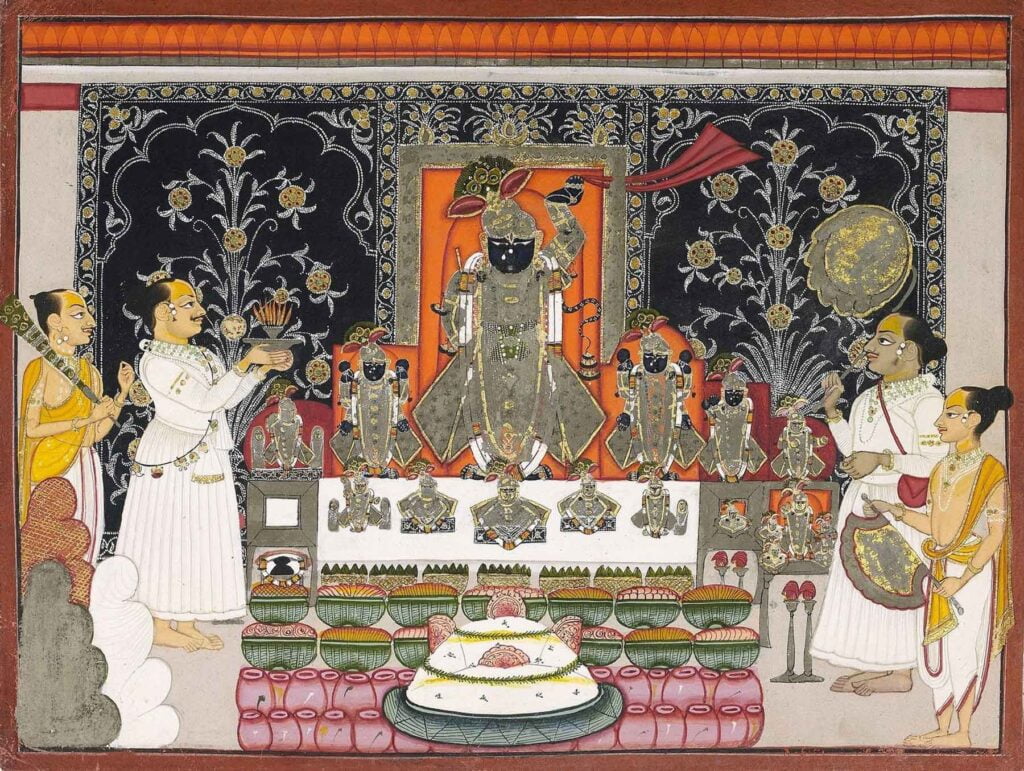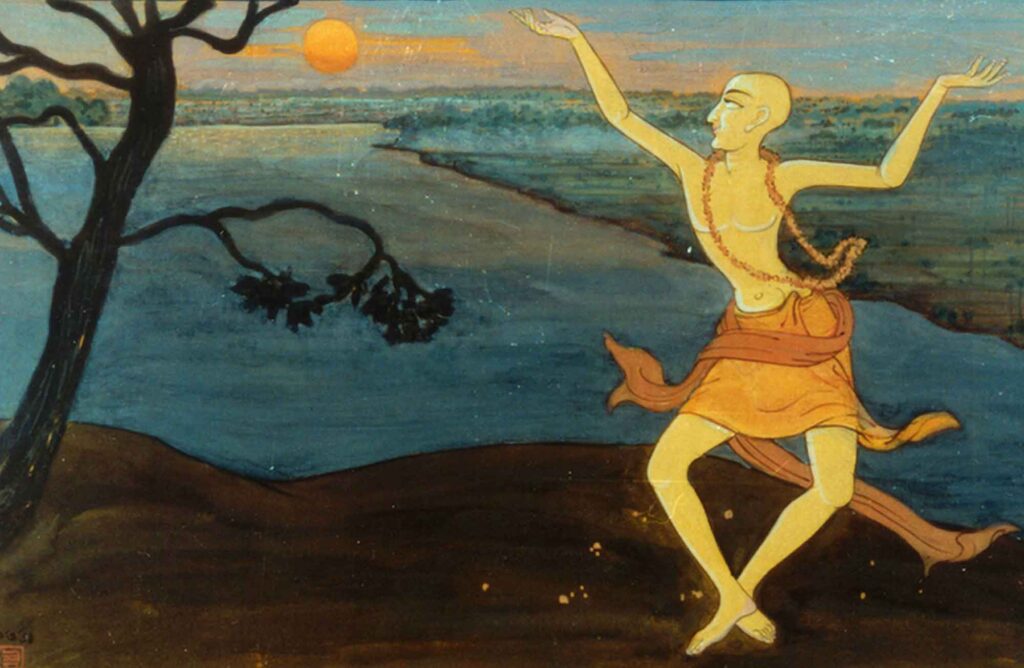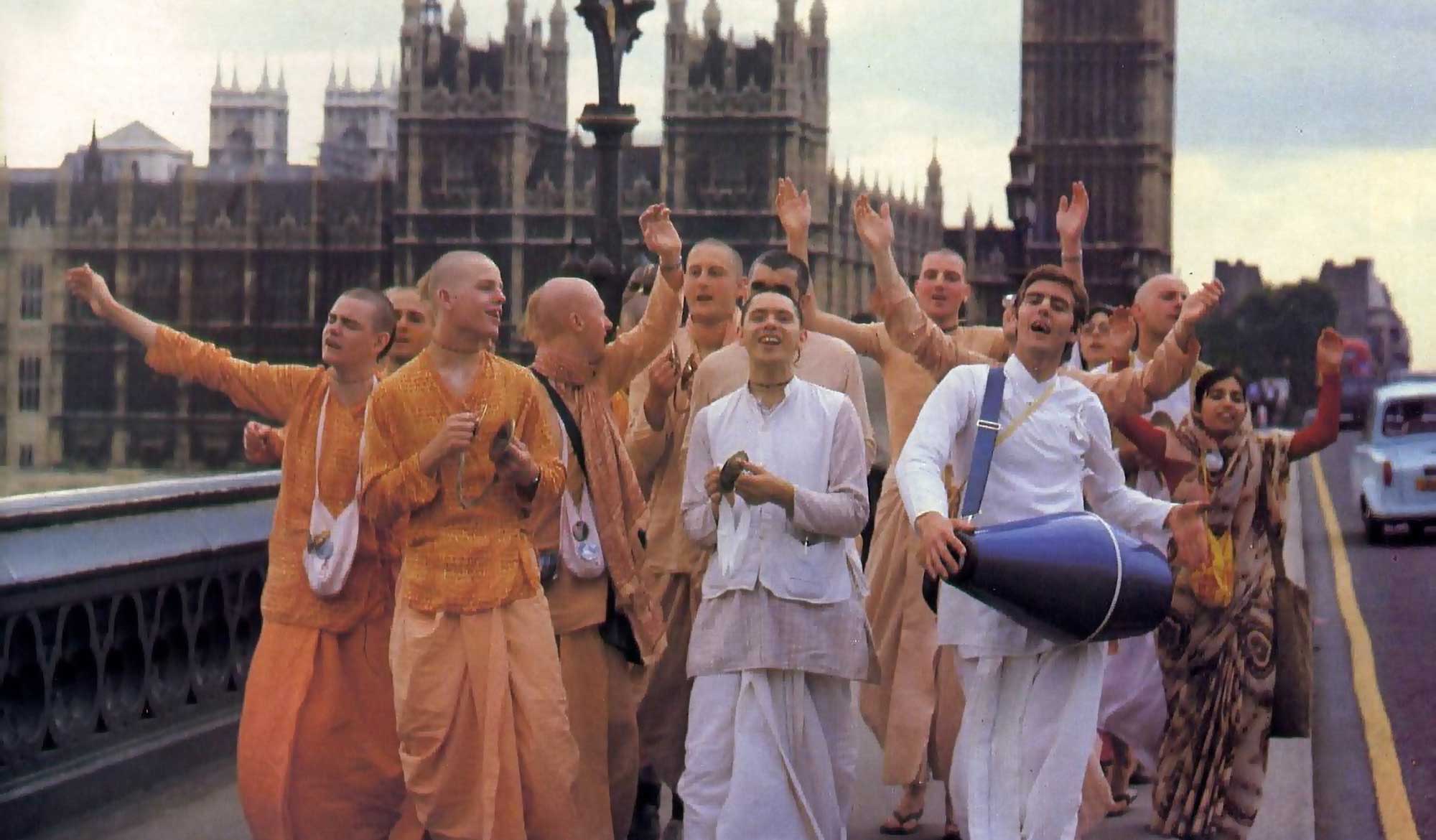Overview
This article about pañca-saṁskāra (the process of initiation) in the Gauḍīya sampradāya was originally published in Sajjana Toṣaṇī, (vol. 2.1) in 1885.
(Translated by Śukavāk Dāsa)
It is said in the śāstras that a person who receives Pañca-saṁskāra can practice two kinds of devotion and gain permanent happiness in the eternal abode of Śrī Hari:
avāpta-pañca-saṁskāro labdha-dvi-vidha- bhaktikaḥ
sākṣāt kṛtya hariṁ tasya dhāmni nityaṁ pramodate
“Persons who read this instruction with faith will want to understand the meaning of the expression pañca-saṁskāra. In order to help them, we will first explain the conventional understanding of the term and then give its deeper significance.” (Prameya Ratnāvali 8.5)
The smṛti-śāstras explain Pañca-saṁskāra in the following manner:
tāpaḥ puṇḍraṁ tathā nāma mantro yāgaś ca pañcamaḥ
amī hi pañca-saṁskārāḥ paramaikānti-hetavaḥ
“Tāpa, puṇḍra, nāma, mantra, and yāga– these five items comprise Pañca-saṁskāra. They are the cause of intense devotion to Lord Hari.” (Prameya Ratnāvali 8.6)
When a faithful person learns about Pañca-saṁskāra, he approaches a religious teacher and humbly requests him for initiation, or dikṣā. After considering the student’s sincerity, the teacher mercifully gives tāpa and puṇḍra to the student in order to sanctify his body. Some religious groups give tāpa by marking the student’s body in various places with the symbols of Lord Viṣṇu’s conch, disc, club and lotus using hot iron brands. Other religious groups imprint the name of Hari with clay using a sandalwood stamp. In reference to tāpa the smṛti śāstras further state:
hari-nāmākṣarair gātram aṅkayet candanādinā
sa loka-pāvano bhūtvā tasya lokam avāpnuyāt
“One who marks his body with the syllables of Hari’s name using sandal paste purifies the world and after death attains the kingdom of God.” (Prameya Ratnāvali 8.6.)
In the Śrī sampradāya of Rāmānuja, tāpa is given by branding the body with the symbols of conch and disc, but Śrī Caitanyadeva has instructed that we mark the body with hari-nāma using sandal paste etc. instead of brands. This rule is a blessing for the souls of Kali-yuga.
Puṇḍra, or tilakā marks, are vertical lines drawn on the body. The śāstras interpret these vertical marks either as symbols representing the Temple of Hari, or as His footprints. Accordingly each religious group has its own prescription for puṇḍra which is universally accepted within that particular group.
Nāma or name is the third saṁskāra. Mercifully the teacher utters the name of Hari into the ear of the faithful student. This name is to be recited daily by the student. (Receiving name means that one understands one’s self to be a servant of Hari. During initiation the teacher also gives a personal a name to the student which indicates devotion to Hari. In the Śrī sampradāya of Rāmānuja, names like Rāma Kṛṣṇa Dāsa, Nārāyaṇa Dāsa, Rāmānuja Dāsa etc. are given. In the Gauḍīya sampradāya names such as Śrī Govinda Dāsa, Śrī Nityānanda Dāsa, Śrī Caitanya Dāsa etc. are used. Since the time of Śrīmad Mahāprabhu names like Ratna-bāhu, Kavi-karṇapūra, Prema-nidhi etc. have been used. Subsequently even names such as Bhāgavata-bhūṣaṇa, Gītā-bhūṣaṇa, Bhakti-bhūṣaṇa etc. are employed.)
The fourth saṁskāra is mantra. Out of his mercy the teacher gives an 18 syllable mantra to his beloved student. (Mantra is the recitation of a short prayer which corresponds to the particular deity one worships. In the worship of Kṛṣṇa an 18 syllable mantra is given.)
The fifth and final saṁskāra is yāga or deity worship. Using the mantra which he has received from his teacher, the student begins the worship of śālagrāma śilā or śrī murti, the Deity of Viṣṇu. This is known as yāga. By receiving pañca-saṁskāra, the five sacraments, a faithful person enters into bhajana-kriyā or the personal worship of God, which eventually leads to pure love for Śrī Hari.
When we analyse the stages that lead to love of God, we understand that faith or śraddhā is the first stage. Without śraddhā, there is no way to obtain love of God. From faith, one seeks saintly association which is called sādhu-saṅga. This leads to shelter at the feet of a spiritual teacher. Thereafter, Pañca-saṁskāra or initiation follows. Pañca-saṁskāra gives rise to bhajana-kriyā or the personal worship of God. Bhajana-kriyā leads to anartha-nivṛtti, which is the stage where one clears up unwanted things from his heart. After anartha–nivṛtti one’s faith can develop and one enters the stage called niṣṭhā or mature faith. From niṣṭhā , taste or ruci develops. This leads to the stage called āsakti or deep attachment. From āsakti spiritual emotions called bhāva spring forth. This eventually ripens into the stage called love of God, prema. Therefore, everyone should seek shelter at the feet of a spiritual teacher and receive Pañca-saṁskāra, which is the source of bhajana. Without Pañca-saṁskāra, bhajana is not spontaneous. Instead, it is performed with difficulty.
Some people think that prema or love of God can be obtained without pañca-saṁskāra. This is incorrect. The conditioned soul in this world has become hostile to the Divine, and consequently his original spiritual nature has become distorted. As a result, he must sanctify himself before that true spiritual nature can develop. And what is the means to attain this pure state? The best way is through saṁskāra or sanctification. Without saṁskāra how can his distorted nature be given up? If we see someone whose nature is not distorted then we think that in a previous birth, through the mercy of a spiritual teacher, he must have received saṁskāra, and on the strength of that saṁskāra he has attained his true spiritual nature wherein prema or love of God has arisen. Otherwise we think that this person has been imperceptibly sanctified by the inconceivable mercy of the Lord Himself. No matter how you look at it, saṁskāra is always there. On the other hand, saṁskāra is not necessary for liberated persons because their nature is not distorted. Distortion of the souls original spiritual nature is the cause of his bondage in this world. For this reason, without saṁskāra the life of the conditioned soul is impure. Even if a person has attained prema on account of previous saṁskāra, still in his present life he again receives saṁskāra in order set a proper example for the good of all.
Saṁskāras exists in all religions and in all countries. The purer a particular religion is, the more its saṁskāras are sacred and complete. Although we have not had the opportunity to thoroughly study the saṁskāras of all religions, we at least can say that the saṁskāras of the Aryan religion appear to be of a higher order than the saṁskāras of other religions. In particular, the saṁskāras of Vaiṣṇava culture are the best part of the Aryan religion. No other practise is as sacred and complete.
The question arises, “if the practise of saṁskāra found in Vaiṣṇava culture is so good, then why are those who practise it still bound by distorted natures?” The answer is that Vaiṣṇava saṁskāra is the best, but at the present time it is practised in name only. Both the spiritual teacher and the student block their own spiritual advancement by being content with the external aspects saṁskāra alone, as I’ve just described. Today, the deeper significance of saṁskāras is not understood at all. When the student submits himself to the teacher, the teacher gives Pañca-saṁskāra and then abandons him. What good can come from Pañca-saṁskāra of this type? Externally the student looks good, but internally there is nothing. The symbols of divine conch, disc and the name of Hari mark the body. The tongue utters the name of Hari and worship of śālagrama-śilā or śrī mūrti with mantra is performed, but the student is addicted to endless sinful practises. At night, he takes intoxicants and practises debauchery! Oh good teacher, how have you benefited your student? What is the difference in him before and after dikṣā? In fact, he is worse. He is a hypocrite. There is no remorse, “I am sinful. It is my fault. How can my sin be given up?” These days, no one thinks like this when they take shelter of a spiritual teacher. Sinful activities are performed without the slightest concern. What misfortune!!
Why is this? The reason is that the wrong kind of relationship exists between teacher and student. The śāstras give rules to guide this relationship, but they are not followed. The student who is burning in the fire of material life, who analyses his predicament and concludes, “My relationship with material nature is not permanent, therefore I must take shelter of a spiritual teacher in order to obtain the feet of God” has reached the stage of faith and is qualified to take shelter of a spiritual teacher. The teacher should study the student for one year and observe his atonement. This is called tāpa. During this examination period the student is encouraged to atone even more and when the teacher is satisfied, he brands the student with the symbols of conch and disc. These marks are permanent and they symbolize the purity that the student must maintain for the rest of his life. This is tāpa, the faithful soul’s first saṁskāra. In English we define the word tāpa as “repentance, atonement, and the permanent impression of higher sentiment on the soul.” Tāpa applies not only to the body, but also to the mind and the soul. If it is only physical, in the form of branding or stamping, then tāpa has not actually taken place and religious practise becomes hypocritical. At the present time this kind of hypocrisy has weakened Vaiṣṇava culture. Without tāpa or inner repentance, the soul cannot live as a Vaiṣṇava. Without tāpa the whole process becomes useless. Without tāpa the heart remains impure. Therefore, good friends, seek atonement without delay!
When the teacher sees that the student has received tāpa properly, (in other words, genuine atonement has occurred) then out of his mercy, the teacher gives him ūrdhva-puṇḍra. What is ūrdhva-puṇḍra? It is effulgence! It is also known as ūrdhva-gati, the path of advancement. After receiving tāpa the student voluntarily accepts a suitable amount of renunciation from worldly activities. This is the path of advancement. However, if the student accepts no renunciation then his tāpa or atonement, is useless. So much trouble! So much asceticism! So much renunciation of one’s happiness! So much work to control lust, anger and greed, but it is all useless labour if one does not perform these austerities in order to obtain Vaikuṇṭha, the kingdom of God. In other words, by taking shelter of sat cit ānanda Lord Hari, a soul follows the path of advancement, ūrdhva-gati. The illumination of the soul, the mind and the body is called ūrdhva-puṇḍra. Aversion to material life and attachment to the Supreme Lord is called tāpa, and puṇḍra and these two ornaments are absolutely necessary for the conditioned soul. Without ūrdhva-puṇḍra the body is as good as dead. Realizing this we must bathe in atonement. Without ūrdhva-puṇḍra the mind drifts and becomes attached to lowly sense objects and then wastes its time discussing the lowest subjects. O repentant soul! Do not delay, mark the body, mind and soul with ūrdhva-puṇḍra and follow the path of advancement which leads to the kingdom of God. Without ūrdhva-puṇḍra the soul’s real nature is extinguished. Therefore, adopt ūrdhva-puṇḍra.
Seeing the beloved student shining with tāpa and ūrdhva-puṇḍra, the teacher gladly gives nāma, the holy name of God which awakens the soul’s eternal nature. The eternal nature of the soul is servitude to the Lord, and by tasting the nectar of the Lord’s holy name the soul is carried to the supreme abode. Then he says, “I am Hari Dāsa. I am not the enjoyer of this world. Even Māyā herself is eternally connected to Kṛṣṇa and I must utilize her in the service of Kṛṣṇa.” The eternal soul is then enchanted by singing the name of Hari. By taking shelter in the nectar of the Lord’s holy name, the soul becomes aware of his own spiritual nature. Intelligent men, always sing the name of Hari! Let the mind always remember the name of Hari. May the soul always be adorned with the name of Hari.
Out of affection, the teacher next gives a mantra that allows his student to easily experience the nectar of the Lord’s holy name. A mantra is a kind of prayer that contains the name of God that is inflected grammatically in the dative case. The mantra also includes certain adjectives that qualify the name of God and allows it to express a particular mood or taste. By giving a mantra the teacher helps his student taste the holy name by selecting a suitable ‘flavour’ for him. When we say “namaḥ”, obeisance to Hari, we employ the 4th or the dative case ending. The dative case expresses the proper relationship between the worshipper, the worshiped and the worship that allows the taste of the holy name to be easily experienced. There is no end to the happiness of a person who has received a mantra. Those who analyse the meaning of the 18 syllable mantra, generally used in the worship of Śrī Kṛṣṇa, know that it is a condensed sampling of the taste available from the Lord. The same also applies to the 24 syllable gāyatrī and other mantras that are often used to worship the Lord. Those who have not received a mantra can only speculate about the taste of the holy name, but unfortunately most of their considerations are useless. Therefore, you must receive a mantra. Those who have received it consider it to be a most important saṁskāra.
There are those who are aware of these principles and yet still are not on solid ground in the matter of worship because they have not received tāpa, puṇḍra, nāma, and mantra from a qualified teacher. Every subject has its rules and regulations and those who reject the rules and regulations of worship often experience difficulty. Therefore, it is said:
śruti-smṛti-purāṇadi-pañcarātra-vidhiṁ vinā
ātyāntikī harer bhaktir utpātāyaiva kalpate
“Devotional service of the Lord that ignores the authorized Vedic literatures like the Upaniṣads, Purāṇas and Nārada-Pañcarātra is simply an unnecessary disturbance in society.” (Bhakti-rasāmṛta-sindhu 1.2.101.)
Therefore my friends! With logic and pure reasoning receive tāpa, puṇḍra, nāma and mantra from a qualified teacher. Not only will you become happy, but by establishing this divine link with God you will benefit all the people around you.
Out of love the teacher next explains the procedure of yāga or Deity worship to his student. Without Deity worship the conditioned soul cannot advance properly. Even though one has received tāpa, puṇḍra, nāma, and mantra the soul’s material condition has not fully abated. Only when one has pleased Lord Hari is the soul freed from this material world at the time of death. Therefore, until the end of life, yāga is necessary even for those who have received mantra. Even though one lives in this world without attachment to matter, still there is danger from matter. Therefore, yāga, or the path of Deity worship, is the proper way to deal with matter. Yāga is the procedure of worshipping the Lord by employing all the physical and mental faculties of seeing, touching, smelling, tasting, thinking, discriminating and acting. Utilising each of these faculties in the worship of śālagrāma, for example, is a good way to cultivate love of God. Service to śrī vigraha, the Deity, is called Vaiṣṇava yāga. No matter what our situation, we must live in this world by working. Therefore, a person who has received mantra has the duty to spend his life worshipping God with devotion following the rules of Deity worship. By teaching yāga the compassionate teacher rescues his student from the ocean of material existence. Yāga is the fifth and final saṁskāra. A person without yāga has no life and he is forced to accept the results of his karma. Therefore, one should live in this world as a Vaiṣṇava and engage in Deity worship. A detailed explanation of the principles of Deity worship is offered in the book Śrī Caitanya-śikṣāmṛta in the discussion under vaidhī-bhakti.
I have now explained both the conventional understanding and the inner significance of the expression pañca-saṁskāra. But still one question arises. Why do teachers not give this kind of instruction to their students today?” The answer is that due to the degenerative effects of time, man’s understanding about the role of spiritual teacher has become extremely corrupt. Today people take instruction from kula-gurus, hereditary family teachers or similar such persons and therefore they are unable to take shelter of a qualified teacher. It is said in the śāstras that the seriously inquisitive student must approach a spiritual teacher who has attained shelter and faith in the Vedas and God, and surrender to him.
tasmād guruṁ prapadyeta jijñāsuḥ śreya uttamam
śābde pare ca niṣṇātaṁ brahmaṇy upaśamāśrayam
(Śrīmad-Bhāgavatam 11.3.21)
When one surrenders in this way, the material ocean diminishes to the size of a calf’s hoof-print. However, if that surrender is in name only, then it is pointless. At the present time most people do not want the shelter of a genuine teacher because very few want to solve the problems of life. However, it is the responsibility of the living soul in this world to search for a teacher and solve these problems. The Lord reveals Himself to the serious student as a teacher to rescue him. It is good to have a strong desire for a teacher, but it is wrong to accept just any person simply to satisfy one’s desire. A genuine teacher will come to one who is sincerely searching, but before the student accepts him he should also examine him for one year. Without examination the teacher-student relationship is only a disturbance.
After close study we conclude that without proper acceptance of pañca-saṁskāra the conditioned soul cannot develop intense devotion to Śrī Hari. Therefore, pañca-saṁskāra is extremely necessary.













